About Chhath Festival
Chhath is a Hindu festival celebrated each year by the people very eagerly. This is very antique festival of the Hindu religion dedicated to the God of energy, also known as Dala Chhath or Surya Shashti. People celebrate this festival to offer thanks to the Lord Surya for blessing the life on the earth as ever. People worship the God Sun very enthusiastically and pray for the well-being, success and progress of their family members, friends, and elders. According to the Hinduism, Sun worship is related to the cure of a range of diseases such as leprosy, etc.
The rituals at this day is to wake up early in the morning, take a holy bath in the Gange and keep fast for whole day, even people do not drink water and they keep themselves standing in the water for a long time. They offer prasad and aragh to the rising sun. It is celebrated in the various states of India like Bihar, UP, Jharkhand and Nepal. According to the Hindu calendar, it is celebrated at 6th day of the month of Kartika (month of October or November).
At some places, Chaiti Chhath is also celebrated in the month of Chaitra (March or April) few days after Holi. It is named as chhath because it is celebrated at the 6th day of the month of Kartika. Chhat puja is very famous in the Dehri-On-Sone, Patna, Dev and Gaya. Now, it is celebrated all over the country.
Chhath Puja 2016 Dates
- Friday, 4th of November 2016 is the day of bath and eat.
- Saturday, 5th of November 2016 is the day of fast which ends after sunset after the 36 hour long fast.
- Sunday, 6th of November 2016 is the day of Sandhya Argh known as the evening offerings.
- Monday, 7th of November 2016 is the day of Suryodaya Argh and the Paran or breaking of the fast.
History and Origin of Chhath Puja
Chhath puja has a great significant in the Hindu religion and it is assumed that the oldest Purohits were requested by the kings to come and perform the traditional puja of the Lord Sun. They chant the ancient Rigveda texts and a variety of hymns for worshiping the Sun. In the ancient, Chhath puja were celebrated by Draupadi and Pandavas of Hastinapur (New Delhi) for solving their instant problem and regaining their lost kingdom.
It is also assumed that the Chhath puja was first started by the Surya Putra Karna. He was a great warrior and had ruled over the Anga Desh (Munger district of Bihar) during the Mahabharata period.
Worship of Chhathi Maiya (consort of the Lord Surya) is held at Chhath puja, Chhathi Maiya is also known as Usha in the Vedas. Usha means dawn (the first light of the day). People pray to Chhathi Maiya to overcome their troubles as well as to get the Moksha or liberation.
Another history behind celebrating the Chhath puja is the story of Lord Rama. It is considered that Lord Rama and Mata Sita had kept fast and offer puja to the Lord Sun in the month of Kartik in Shukla Paksh during their coronation after returning to the Ayodhya after 14 years of exile. From that time, chhath puja became the significant and traditional festival in the Hindu religion and started celebrating every year at the same date.
Chhath Puja Katha
A long year ago, there was a king named, Priyavrat and his wife Malini. They were living very happily but there was a big unhappiness in their life as they have no child. They decided to make a big Yagya by the help of Maharishi Kashyap in order to be blessed with a child. His wife became pregnant because of the effect of Yagya. But she had given birth to a dead child after nine months. King was very sad and decided to suicide. Suddenly, there came a Goddess in front of him while suicide. Goddess said that, I am a Goddess Khashti, if someone would offer puja to me with pure mind and soul, he would definitely get a child. The king, Priyavrat did the same and blessed with a very beautiful and cute child. Since then, people started celebrating the chhath puja.
Rituals and Traditions of Chhath Puja
It is believed that worshipers of the Chhath take holy bath and follows a period of abstinence and become separate for 4 days from the main family. Throughout the period he is believed as the pure spirit and sleep on the floor having single blanket. There is a normal belief that once a family begins Chhatt Puja, he has to perform it yearly as well as pass it to his next generations and it can only be skipped when there is a death of any person in the family that year.
Devotees offer prasad to Sun at the Chhath such as sweets, Kheer, Thekua and fruits included in a small bamboo tokari. The prasad should be cooked without salt, onions or garlic with maintained purity. It is a four days festival which includes:
- On the first day, devotees take bathe early in the morning in the holy water of Gange and bring some water to their home to prepare the offerings. The home and its surroundings should be cleaned at this day. They take only one meal a day known as kaddu-bhat cooked only by using the bronze or soil utensils and mango woods over the soil stove.
- On the second day (the day before Chhath), Panchami, devotees keeps fast for whole day and break their fast in the evening after sunset after the worship of Sun. They offer Rasiao-kheer, puris, fruits in the puja. After taking meal in the evening, they go on a fast without water for the next 36 hours.
- On the third day (day of Chhath) they offer the Sanjhiya Arghya at the ghat of riverbank. After Arghya, they wear the single saree of turmeric color. Other family members are waiting for getting the blessings from worshiper. At the night of Chhath a vibrant event of Kosi is celebrated by lighting the lamps of clay diyas under the covering of five sugarcane sticks. The five sugarcane sticks indicate the Panchatattva (earth, water, fire, air and space) that human body made of Panchatattva.
- On the early morning of the fourth day (Paarun), devotees along with their family and friends offer Bihaniya Aragh at the ghat of riverbank of Gange. Devotees end their festival through breaking the fast by having the Chhath prashad.
Stages of Chhath Puja
There are six great stages of the Chhath puja which are:
- The belief of fast and cleanliness of body on the festival identify the detoxification of the body and mind in order to set up the body and mind to accept the cosmic solar energy.
- Standing in water with half of the body inside the water diminishes the escape of energy as well as facilitates the prana to elevate to the sushumna.
- Then the entrance of cosmic solar energy takes place in the pineal, pituitary and hypothalamus glands (known as the Triveni complex) by the retina and optic nerves.
- In the 4th stage Triveni complex gets activated.
- After activation of the Triveni complex, spine gets polarized and body of devotee gets transformed into a cosmic powerhouse and gets the Kundalini Shakti.
- At this stage the devotee is fully able to conduct, recycle and pass on the energy into entire universe.
Benefits of the Processes of Chhath puja
- It is the way of detoxifying the body and mind which lead to the biochemical changes.
- Through detoxification it becomes possible to control the flow of prana as well as getting more energetic. It improves the look of skin, develops better eyesight and the ageing process gets slow down.
Benefits of Chhath Puja
- Devotee of the Chhath puja can improve the immunity of body.
- A variety of skin infections can be cured through the safe radiations of sunlight.
- It increases the fighting power of blood by improving the performance of WBC.
- Solar energy provides the power to control the secretion of hormones.
Daily sun meditation relaxes the body and mind. Pranayam, yoga, meditation are also the way to improve the control on body and mind. Pilgrims comes at Varanasi for a peaceful yoga and meditation at the bank of river Ganga.
Significance of Chhath Puja
Chhath puja has a special significance during the Sunrise and Sunset periods. The Sunrise and sunset are the most important periods of the day during which a human body can safely get the solar energy without any harm. That’s why there is a myth of offering the Sanjhiya Arghya and Bihaniya Arghya to the Sun at the Chhath festival. During this period the solar energy has low level of ultraviolet radiations so it is safe for the human body. People perform the Chhath puja in order to thank the Lord Sun for continuing the life on the earth as well as to get blessings.
The ritual of Chhath puja provides mental calmness (by detoxifying the body and mind), enhances the energy level and immunity, reduces the frequency of anger, jealous as well as lot of negative emotions. It is also believed that following the Chhath processes helps in slowing down the ageing process. Such beliefs and rituals of the Chhath make it the most significant festival in the Hinduism.
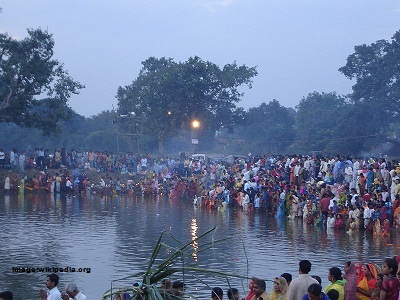 This is the celebration of the Chhath Pooja early in the morning by the people. There is a great crowd all around the river by the people who are celebrating the Chhath Pooja early in the morning by offering Jal to the God Sun
This is the celebration of the Chhath Pooja early in the morning by the people. There is a great crowd all around the river by the people who are celebrating the Chhath Pooja early in the morning by offering Jal to the God Sun
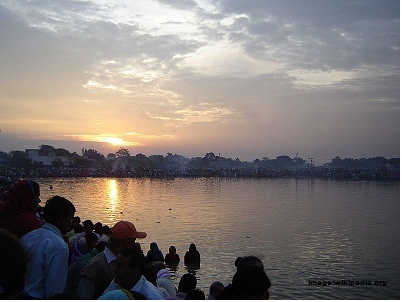 What a nice photograph of the Chhath Pooja celebration at the Bank of the River. They are taking holy bath early in the morning in order to complete their Chhath Pooja and get a lot of blessings from the God.
What a nice photograph of the Chhath Pooja celebration at the Bank of the River. They are taking holy bath early in the morning in order to complete their Chhath Pooja and get a lot of blessings from the God.
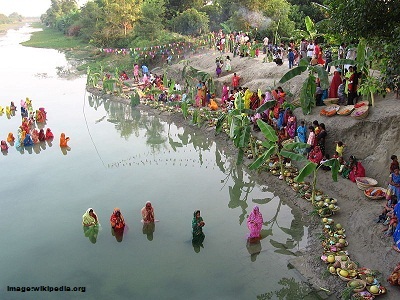 Women devotees are celebrating Chhath Pooja in their own way and in such a beautiful manner. They are offering some Prasad to the God in their Tokari. They are also worshipping the banana tree. Some of them are taking bath and some of them are sitting at the bank of river. Whereas some of them are standing away from bank of the river.
Women devotees are celebrating Chhath Pooja in their own way and in such a beautiful manner. They are offering some Prasad to the God in their Tokari. They are also worshipping the banana tree. Some of them are taking bath and some of them are sitting at the bank of river. Whereas some of them are standing away from bank of the river.
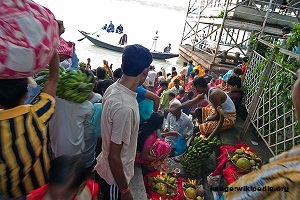 Pilgrims of the Chhath Pooja are buying fruits for offering to the God in the form of Prasad. What a nice pic of the event early in the morning at the ghat of Ganga. Sellers are selling their fruits to the devotees and helping to the devotees for completing the Chhath Pooja.
Pilgrims of the Chhath Pooja are buying fruits for offering to the God in the form of Prasad. What a nice pic of the event early in the morning at the ghat of Ganga. Sellers are selling their fruits to the devotees and helping to the devotees for completing the Chhath Pooja.
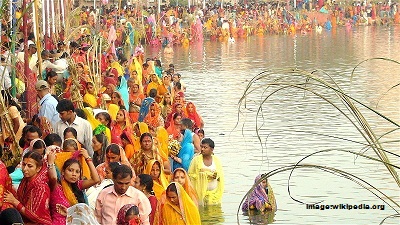 Such a awesome snap of the event where women are taking bath in the River by having a sugarcane in their hand. They are celebrating the Chhath Pooja in the completely traditional and cultural manner. Men are also there for helping the women.
Such a awesome snap of the event where women are taking bath in the River by having a sugarcane in their hand. They are celebrating the Chhath Pooja in the completely traditional and cultural manner. Men are also there for helping the women.
